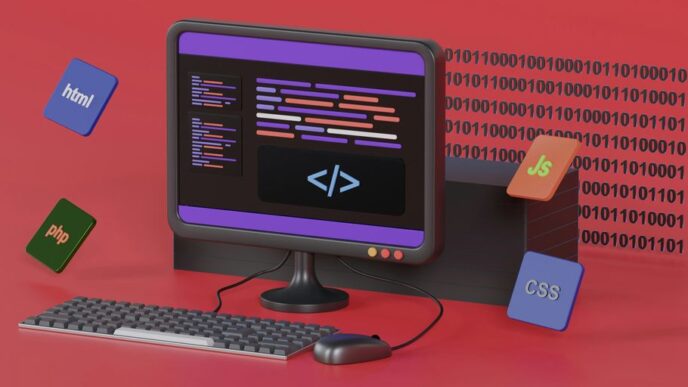Ever wonder why some things just seem to work out better with less effort? That’s the magic of the 80/20 rule in software development. It’s like finding out that a small part of your work can actually do most of the heavy lifting. Imagine spending less time on the grind and still getting top-notch results. Sounds great, right? In this article, we’ll break down how this principle can be your best friend in coding, helping you focus on what truly matters and cutting out the noise.
Key Takeaways
- The 80/20 rule suggests that a small portion of your efforts can lead to most of your results. In software, this means focusing on the key tasks that drive the biggest impact.
- Implementing the 80/20 rule involves identifying high-value tasks, prioritizing them, and using tools that help streamline your workflow.
- Challenges in applying this rule include recognizing resistance and avoiding pitfalls, but with the right strategies, it can lead to significant improvements in productivity.
Understanding the 80 20 Rule in Software Development

Origins and Concept of the Pareto Principle
The Pareto Principle, also known as the 80/20 rule, is a fascinating concept that traces its roots back to Vilfredo Pareto, an Italian economist. In the late 19th century, he observed that 80% of Italy’s wealth was owned by 20% of the population. This principle has since found applications in various fields, including software development. Essentially, it suggests that a small percentage of causes are responsible for a large percentage of outcomes. In software, this might mean that a few critical pieces of code are responsible for the majority of a system’s functionality or performance.
Applications in Software Development
In the world of software development, the 80/20 rule can be a game-changer. Here’s how it typically manifests:
- Bug Fixing: Often, 80% of bugs originate from 20% of the code. By identifying and focusing on these problematic areas, developers can significantly improve the software’s reliability.
- Feature Development: A small set of features usually delivers most of the value to users. Prioritizing these can lead to better user satisfaction and more efficient use of resources.
- Learning and Growth: Developers often find that a handful of skills or tools account for the majority of their productivity. Focusing on mastering these can lead to significant career advancement.
Common Misconceptions About the 80 20 Rule
Despite its widespread use, the 80/20 rule is often misunderstood. Here are some common misconceptions:
- It’s a Hard Rule: People often think the 80/20 split is exact, but it’s more of a guideline. The actual ratio might vary depending on the context.
- It Ignores the Other 80%: Some believe it means ignoring the less impactful 80%, but that’s not the case. It’s about prioritizing without neglecting the rest.
- It’s Always Applicable: While powerful, the 80/20 rule doesn’t fit every situation. Some projects might have more even distributions of effort and impact, requiring a different approach.
Implementing the 80 20 Rule for Maximum Impact
Identifying High-Value Tasks
In software development, it’s crucial to pinpoint the tasks that really move the needle. Start by listing out everything you do in a typical week. Then, look at which tasks directly contribute to your project goals. You might find that only a handful of tasks are actually pushing things forward. These are your high-value tasks.
- List All Tasks: Jot down everything you do, from coding to meetings.
- Analyze Impact: Determine which tasks lead to major progress or results.
- Focus on Key Outcomes: Zero in on tasks that align with your goals and have the most significant impact.
Strategies for Prioritization
Once you’ve identified the key tasks, it’s time to prioritize. This can be challenging, especially when everything seems important. But remember, not all tasks are created equal.
- Use a Priority Matrix: This tool helps in sorting tasks based on urgency and importance.
- Set Clear Goals: Know what you want to achieve and prioritize tasks that help you get there.
- Limit Daily Priorities: Focus on three to five critical tasks each day to maintain quality and avoid burnout.
Tools to Aid Implementation
There are plenty of tools out there to help you stick to the 80/20 rule. Time-tracking apps, project management software, and even simple to-do lists can make a big difference.
- Time-Tracking Apps: These can help you see where your time goes and adjust accordingly.
- Project Management Software: Use tools like Trello or Asana to keep track of tasks and deadlines.
- To-Do Lists: A simple list can help you focus on what needs to be done, ensuring you tackle the most important tasks first.
By applying these strategies and using the right tools, you can ensure that your efforts are directed towards the tasks that truly matter, leading to greater productivity and success in your projects.
Overcoming Challenges in Applying the 80 20 Rule
Recognizing and Addressing Resistance
Applying the 80/20 rule in software development can be tough. People often resist change, especially when it means shifting focus from tasks they’re used to. To tackle this, start by having open conversations. Explain the benefits of focusing on the crucial 20% of tasks that drive the majority of results. Encourage team members to share their concerns and address them head-on. Building a culture that values flexibility and adaptation can ease the transition.
Avoiding Common Pitfalls
The 80/20 rule isn’t a one-size-fits-all solution. Sometimes, it might not be clear which tasks fall into that magic 20%. To avoid missteps, regularly review and analyze your projects. Use data to back up your decisions about which tasks truly matter. Another pitfall is becoming too rigid with the rule—remember, it’s a guideline. Be ready to adjust your approach as projects evolve.
Adapting the Rule to Different Scenarios
Every software project is unique, and the 80/20 rule may not apply in the same way to each one. In some cases, focusing too much on a small set of tasks might mean missing out on other important areas. Be aware of the context and adapt the rule accordingly. For instance, in projects with interconnected tasks, a broader perspective might be needed. Always be prepared to blend the 80/20 rule with other strategies to fit the specific scenario at hand.
Success Stories and Case Studies

Real-World Examples in Software Development
Applying the 80/20 rule in software development isn’t just a theory—it’s a practice that has brought tangible results to many. Here are some real-world examples:
- Bug Fixing Efficiency: A tech startup found that 80% of their software bugs were caused by just 20% of the codebase. By focusing their efforts on this critical 20%, they were able to drastically reduce bug-related issues and improve software stability.
- Customer Feedback Prioritization: A SaaS company realized that 80% of customer complaints stemmed from just 20% of their features. By prioritizing fixes and improvements on these features, they enhanced user satisfaction and retention rates.
- Development Time Allocation: Another team discovered that 20% of their development tasks contributed to 80% of the project’s value. By reallocating resources to these high-impact tasks, they accelerated their development timeline and delivered the project ahead of schedule.
Lessons Learned from Successful Implementations
Implementing the 80/20 rule isn’t always straightforward, but the lessons learned can guide future applications:
- Data-Driven Decisions: Successful teams often use data analytics to identify which 20% of tasks or issues to focus on. This ensures that efforts are directed where they matter most.
- Continuous Monitoring: The 80/20 distribution can shift over time. Regularly reviewing and adjusting focus areas is crucial to maintaining efficiency.
- Team Involvement: Engaging the entire team in identifying the critical 20% fosters a sense of ownership and enhances collaboration.
Future Trends and Innovations
Looking ahead, the 80/20 rule will continue to evolve with technological advancements:
- AI and Machine Learning: These technologies can automate the identification of the 20% of tasks or issues that need attention, making the process faster and more accurate.
- Integration with Agile Practices: As Agile methodologies continue to dominate software development, integrating the 80/20 rule can further streamline workflows and enhance productivity.
- Customization and Personalization: Future tools may offer more personalized recommendations on where to apply the 80/20 rule, tailored to specific team dynamics and project needs.
The 80/20 rule remains a powerful strategy in software development, offering a path to greater efficiency and success. By focusing on the most impactful elements, teams can achieve more with less effort, paving the way for innovation and growth. For those looking to enhance their digital PR and brand awareness, platforms like PRNEWS.IO offer comprehensive solutions that align well with these principles.
Explore how others have achieved their goals with our services! These success stories show real results and inspire new ideas. Want to see what we can do for you? Visit our website today to learn more!
Conclusion
So, there you have it. The 80/20 rule isn’t just some fancy theory; it’s a practical tool that can really make a difference in software development. By zeroing in on the tasks that truly matter, you can boost productivity without burning out. It’s about working smarter, not harder. Sure, it might take a bit of trial and error to figure out what that crucial 20% is, but once you do, the payoff is worth it. Whether you’re squashing bugs or rolling out new features, focusing on the right things can lead to big wins. So, give it a shot and see how it transforms your workflow. Remember, it’s not about doing more—it’s about doing what counts.














